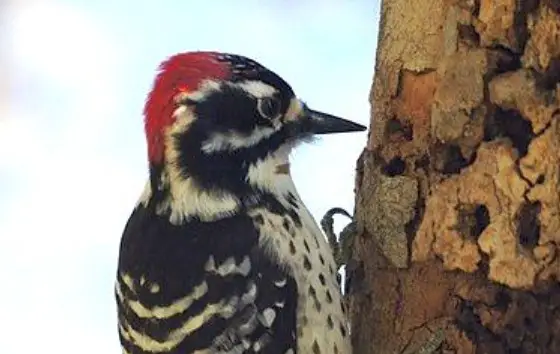Tireless woodpeckers sometimes knock on wood for hours to get their food. This behavior has long given rise to questions from people – how does this bird feel, using its head like a hammer? However, scientists have long understood the physiology of woodpeckers and found that nature has perfectly adapted them to such a peculiar way of finding food.

- In warm regions on the other side of the world, there are sucker woodpeckers, a significant part of the diet of which is tree sap. After they get drunk, hummingbirds flock to the holes they made for their share of juice, which also loves it, but cannot get it on their own.
- North and Central America is home to Gila woodpeckers, which live on giant Carnegia cacti. At the same time, they eat insects that harm these plants.
- Ground woodpeckers do not make holes in the bark, but directly in the soil. They feed on insects that live in its upper layer.
- The tail plumage of woodpeckers is stiff and sharp. The tip of such a feather can even cut yourself.
- Once, because of woodpeckers, American astronauts went into space with a significant delay, as the prelaunch check revealed that woodpeckers had punched about two hundred holes in the outer layer of the space shuttle’s thermal insulation.
- Acorn woodpeckers store oak acorns, their main food, in holes, which they make in the trunks of these same oaks.
- Common woodpeckers love to feast on ants, which are abundant under the bark of many old trees. An adult woodpecker can easily eat up to a thousand pieces at a time.
- On the paws of woodpeckers, two fingers are directed forward, and two more – back. At the same time, all other birds have three fingers directed forward, and only one backward.
- Some species of woodpeckers, for example, large spotted ones, willingly eat other people’s eggs and even chicks if possible.
- The impact energy of the beak on a tree is absorbed by a special cartilaginous tissue located between the skull and, in fact, the woodpecker’s beak.
- Each time this bird strikes, a special muscle pushes its skull away from its beak.
- All birds use the tail unit as a rudder, but for woodpeckers, the tail also serves as support with which they climb trees. From such use, the hardtail feathers are erased, and in a year the tail loses up to 1/10 of its length.
- The woodpecker’s nostrils located on the beak are closed with coarse hair, which protects the lungs from the ingress of wood dust.
- Woodpeckers are capable of inflicting up to 20 blows to wood per second.
- With the help of a loud knock on a tree, woodpeckers let their relatives know that the territory is already occupied.
- There are 220 different species of these birds on Earth. The largest ones weigh up to 400-500 grams, and the smallest ones weigh less than 10 grams.
- Woodpeckers spend most of their lives in trees. Of course, they know how to fly, but they do not like this activity too much.
- The woodpecker’s skull is larger in relation to the size of its body than that of most other birds.
- Of all species of woodpeckers, only acorns live in flocks. All others lead either a single or a coupled lifestyle.

